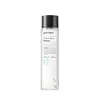What's inside
What's inside
 Key Ingredients
Key Ingredients

 Benefits
Benefits

 Concerns
Concerns

 Ingredients Side-by-side
Ingredients Side-by-side

Water
Skin ConditioningPropanediol
SolventNelumbo Nucifera Germ Extract
Skin ConditioningNiacinamide
SmoothingGlycereth-26
HumectantGlycerin
Humectant1,2-Hexanediol
Skin ConditioningMethyl Gluceth-20
HumectantCitric Acid
BufferingXanthan Gum
EmulsifyingEthylhexylglycerin
Skin ConditioningSodium Citrate
BufferingAdenosine
Skin ConditioningDisodium EDTA
Sodium Hyaluronate
HumectantSaccharomyces Ferment
Skin ConditioningPotassium Hydroxide
BufferingAcetic Acid
BufferingWater
Skin ConditioningDipropylene Glycol
HumectantGlycerin
HumectantSorbitol
HumectantCyclopentasiloxane
EmollientAlcohol
AntimicrobialCyclohexasiloxane
EmollientBetaine
HumectantPhenyl Trimethicone
Skin ConditioningPhenoxyethanol
PreservativeDimethiconol
EmollientPEG-5 Glyceryl Isostearate
EmollientPolyacrylamide
Triethanolamine
BufferingCarbomer
Emulsion StabilisingPEG-8 Glyceryl Isostearate
EmollientMethylparaben
PreservativeC13-14 Isoparaffin
EmollientParfum
MaskingPEG-20 Glyceryl Isostearate
PEG-40 Hydrogenated Castor Oil
EmulsifyingDisodium EDTA
Laureth-7
Emulsifying1,2-Hexanediol
Skin ConditioningBacillus/Soybean Ferment Extract
Skin ConditioningAllantoin
Skin ConditioningTocopheryl Acetate
AntioxidantHyaluronic Acid
HumectantCamellia Sinensis Leaf Water
MaskingAloe Barbadensis Leaf Juice
Skin ConditioningButylene Glycol
HumectantEthylhexylglycerin
Skin ConditioningCI 19140
Cosmetic ColorantSophora Angustifolia Root Extract
Skin ConditioningMelia Azadirachta Extract
Skin ConditioningCitrus Paradisi Fruit Extract
Skin ConditioningPentylene Glycol
Skin ConditioningCI 42090
Cosmetic ColorantCaprylyl Glycol
EmollientWater, Dipropylene Glycol, Glycerin, Sorbitol, Cyclopentasiloxane, Alcohol, Cyclohexasiloxane, Betaine, Phenyl Trimethicone, Phenoxyethanol, Dimethiconol, PEG-5 Glyceryl Isostearate, Polyacrylamide, Triethanolamine, Carbomer, PEG-8 Glyceryl Isostearate, Methylparaben, C13-14 Isoparaffin, Parfum, PEG-20 Glyceryl Isostearate, PEG-40 Hydrogenated Castor Oil, Disodium EDTA, Laureth-7, 1,2-Hexanediol, Bacillus/Soybean Ferment Extract, Allantoin, Tocopheryl Acetate, Hyaluronic Acid, Camellia Sinensis Leaf Water, Aloe Barbadensis Leaf Juice, Butylene Glycol, Ethylhexylglycerin, CI 19140, Sophora Angustifolia Root Extract, Melia Azadirachta Extract, Citrus Paradisi Fruit Extract, Pentylene Glycol, CI 42090, Caprylyl Glycol
Ingredients Explained
These ingredients are found in both products.
Ingredients higher up in an ingredient list are typically present in a larger amount.
1,2-Hexanediol is a synthetic liquid and another multi-functional powerhouse.
It is a:
- Humectant, drawing moisture into the skin
- Emollient, helping to soften skin
- Solvent, dispersing and stabilizing formulas
- Preservative booster, enhancing the antimicrobial activity of other preservatives
Disodium EDTA plays a role in making products more stable by aiding other preservatives.
It is a chelating agent, meaning it neutralizes metal ions that may be found in a product.
Disodium EDTA is a salt of edetic acid and is found to be safe in cosmetic ingredients.
Learn more about Disodium EDTAEthylhexylglycerin (we can't pronounce this either) is commonly used as a preservative and skin softener. It is derived from glyceryl.
You might see Ethylhexylglycerin often paired with other preservatives such as phenoxyethanol. Ethylhexylglycerin has been found to increase the effectiveness of these other preservatives.
Glycerin is already naturally found in your skin. It helps moisturize and protect your skin.
A study from 2016 found glycerin to be more effective as a humectant than AHAs and hyaluronic acid.
As a humectant, it helps the skin stay hydrated by pulling moisture to your skin. The low molecular weight of glycerin allows it to pull moisture into the deeper layers of your skin.
Hydrated skin improves your skin barrier; Your skin barrier helps protect against irritants and bacteria.
Glycerin has also been found to have antimicrobial and antiviral properties. Due to these properties, glycerin is often used in wound and burn treatments.
In cosmetics, glycerin is usually derived from plants such as soybean or palm. However, it can also be sourced from animals, such as tallow or animal fat.
This ingredient is organic, colorless, odorless, and non-toxic.
Glycerin is the name for this ingredient in American English. British English uses Glycerol/Glycerine.
Learn more about GlycerinWater. It's the most common cosmetic ingredient of all. You'll usually see it at the top of ingredient lists, meaning that it makes up the largest part of the product.
So why is it so popular? Water most often acts as a solvent - this means that it helps dissolve other ingredients into the formulation.
You'll also recognize water as that liquid we all need to stay alive. If you see this, drink a glass of water. Stay hydrated!
Learn more about Water